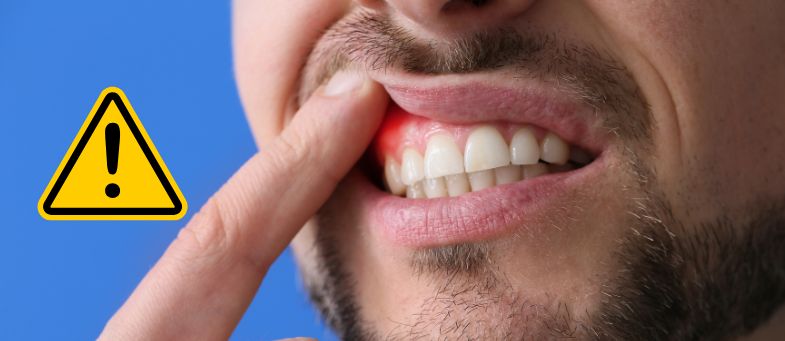Are you frequently spotting blood on your brush? Do you feel your mouth has a bad odor? If yes, then there is a chance of you having gum disease- or it’s just the onset. Gum diseases are becoming increasingly prevalent, and you will be shocked to know that nearly half of adults over 30 show some signs of it. This alarming trend highlights the importance of understanding the causes, recognizing the warning signs, and visiting a dental clinic to protect your oral and overall health. Through this blog, we aim to share with you the warning signs of gum disease and ways to treat it.
Factors Leading to Gum Disease:
- Poor oral hygiene: The primary culprit is plaque. If not removed through regular brushing and flossing, plaque can harden into tartar, irritating your gums and creating a breeding ground for harmful bacteria.
- Smoking: Smoking weakens your body's overall immune system, making it harder to fight the infection, including gum disease. It also impairs blood flow to the gums, thus, causing a delay in healing.
- Genetics: Some people are genetically predisposed to gum disease, making them more susceptible even with good oral hygiene.
- Hormonal changes: Fluctuations in hormone levels, particularly during pregnancy or menopause, can make gums more sensitive and vulnerable to inflammation.
- Certain medications: Some medications can reduce saliva flow, leading to dry mouth, which increases the risk of gum disease.
- Medical conditions: Conditions like diabetes and heart disease can increase your risk of developing gum disease.
Warning Signs of Gum Disease
Gum disease often shows its sign after a certain time; so, it is important to keep checking the early signs and visiting a dental clinic before it’s too late.
- Red, swollen, or tender gums: Healthy gums are pink and firm. If your gums look red, swollen, or feel tender to the touch, it could be a sign of inflammation.
- Bleeding gums: Bleeding while brushing or flossing is common until it happens every day.
- Receding gums: If your gums seem to be pulling away from your teeth, exposing more of the tooth root.
- Persistent bad breath: Bad breath that doesn't go away even with brushing and flossing can be a sign of gum disease. Bad breath generally happens due to certain bacteria associated with gum disease.
- Loose teeth: As gum disease progresses, you see more damage in the supporting structures of your teeth. This leads to loose teeth or shifting of teeth.
- Changes in your bite: If you notice changes in the way your teeth fit together when you bite, it could be a sign of gum disease affecting the alignment of your teeth.
How to Treat Gum Disease:
The good news is that gum disease can often be treated effectively, especially when detected early. Treatment options vary depending on the severity of the disease:
Non-surgical treatments:
In the early stages of gum disease, which is also called gingivitis, only dental cleaning (scaling) is done. With this simple procedure, you get rid of plaque and tartar buildup, thereby allowing your gums to heal.
Surgical treatments:
For more advanced gum disease (periodontitis), surgical procedures may become necessary:
- Flap surgery: This involves lifting back the gums to remove tartar and bacteria from deep pockets and smooth the root surfaces.
- Bone grafts: If the bone supporting your teeth has been damaged, bone grafts can help regenerate lost bone.
- Soft tissue grafts: If you have gum recession, soft tissue grafts can help cover exposed roots and restore gum tissue.
Gum disease is a serious condition, but is often preventable and treatable. Remember, to have healthy & strong teeth, you must have a strong foundation, which means you should have your gums in their best condition. Look for the warning signs and seek treatment from a reputed dental clinic who specializes in treating gum diseases.


